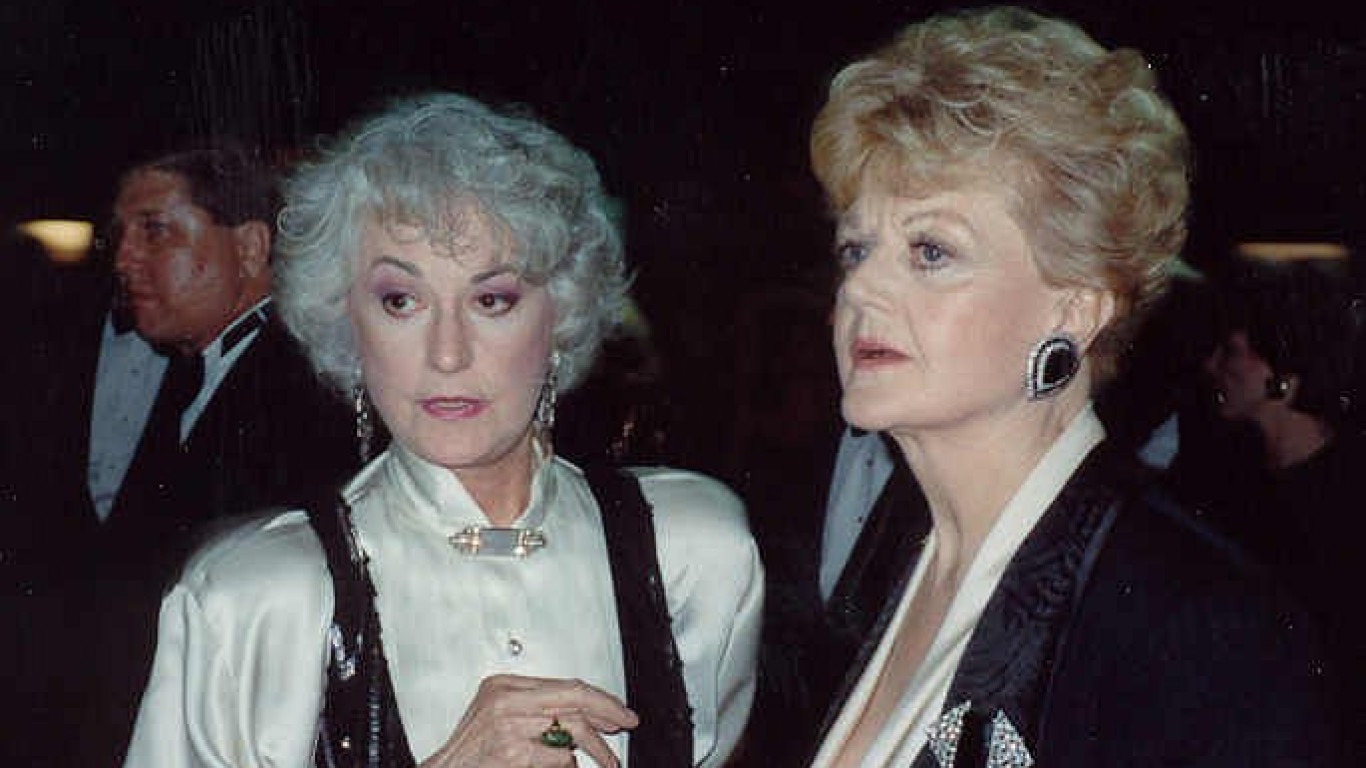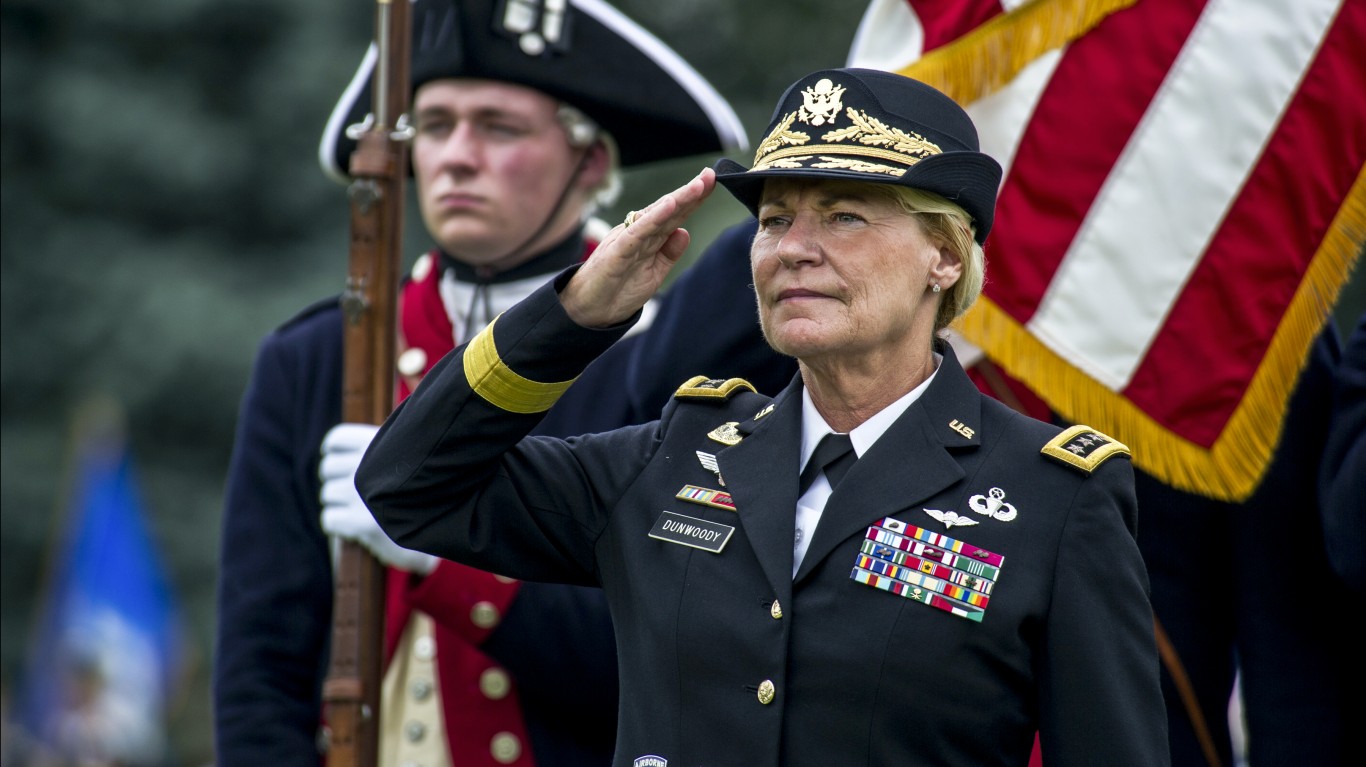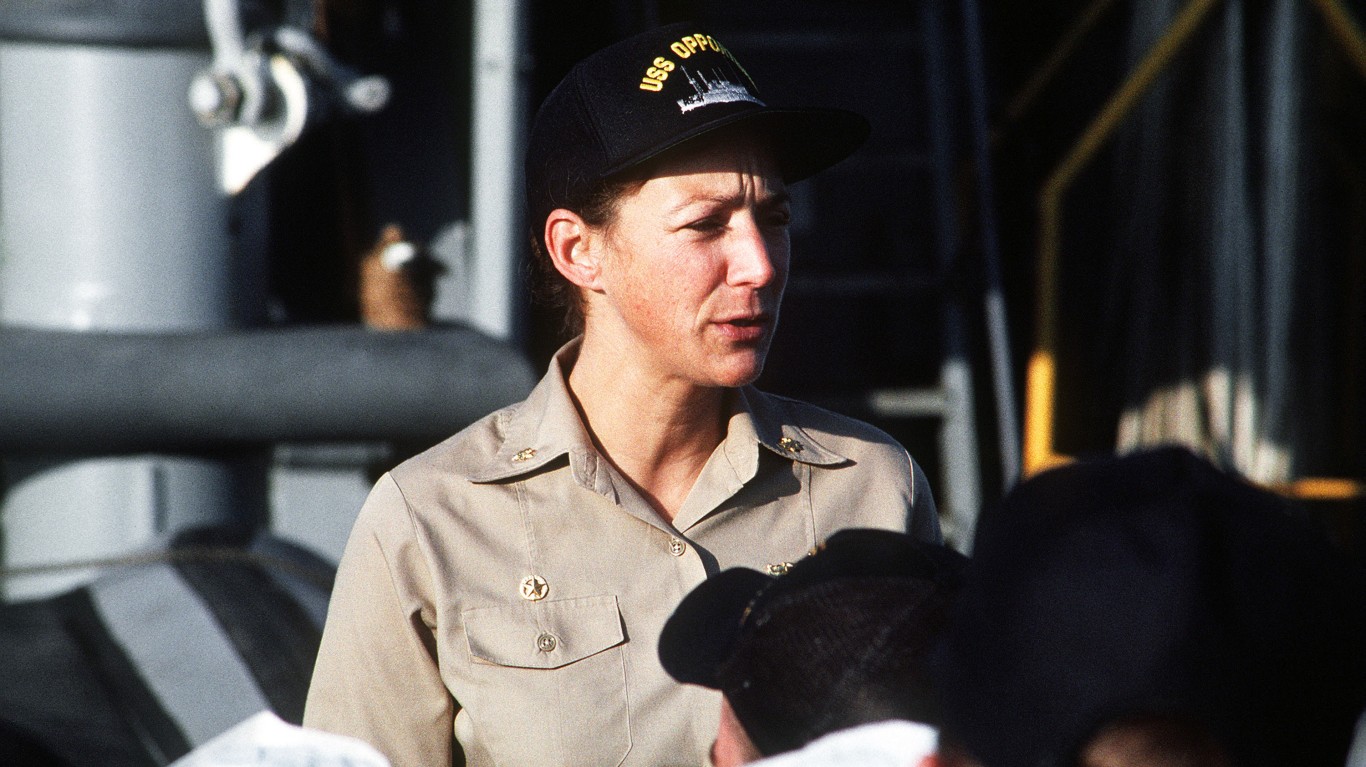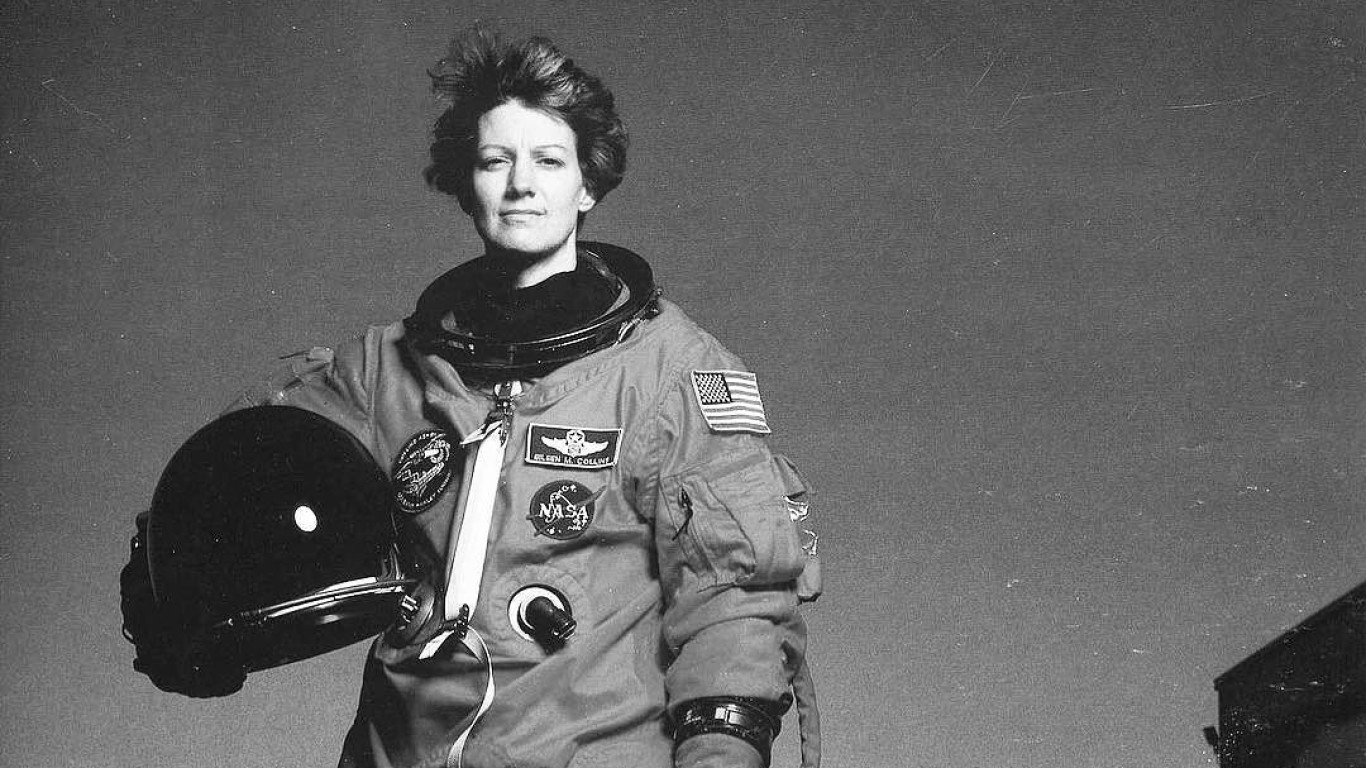
To commemorate the 50th anniversary of women flying in the U.S. Navy, a group of women made history at this year’s Super Bowl on Feb. 12 at State Farm Stadium in Glendale, Arizona, when they became the first all-woman flight crew to perform the flyover before the annual NFL championship game. The Navy said in a statement that 11 women were selected as the flight crew for four of the most advanced warplanes in the U.S. arsenal: the F-35C Lightning II, two F/A-18F Super Hornets; and an EA-18G Growler electronic warfare aircraft. The logistics and maintenance crews for the performance are also all women, the Navy added.
These women are symbolic of the U.S. military’s acceptance – often initially reluctant – of women, dating back to the Civil War all the way up to the most recent performance of a Super Bowl tradition. (These are the countries with the most women serving in the military.)
To identify 20 female veterans who changed U.S. history, 24/7 Tempo reviewed a number of internet sources, including Army Times and Military.com, to learn about women who served in the military and stood out in their role of changing history in some way.
The list includes Underground Railroad “conductor” Harriet Tubman, who spent decades fighting for recognition of her service as a Union Army scout and spy during the Civil War.
Three women on this list were prisoners of war: a Civil War Union Army field surgeon who scandalized colleagues by wearing trousers, an Army nurse who saved the lives of fellow prisoners held by the Japanese during World War II, and a flight surgeon who was shot down during the First Gulf War of 1990-91.
There’s the late Grace Brewster Murray Hopper, a Yale-educated mathematician, computer scientist, and U.S. Navy rear admiral who served in the military for a half century and whose programming language utilizing English words and syntax helped to create the immensely popular COBOL computer language.
Click here to see female veterans who changed U.S. history
Half of these women began their military service before the end of World War II. Five of them entered military service in the 1970s and five began their military careers as early as 1982, including the first two female Army Ranger School graduates from the class of 2015. (Here’s what it takes to be in 16 of America’s elite military forces.)
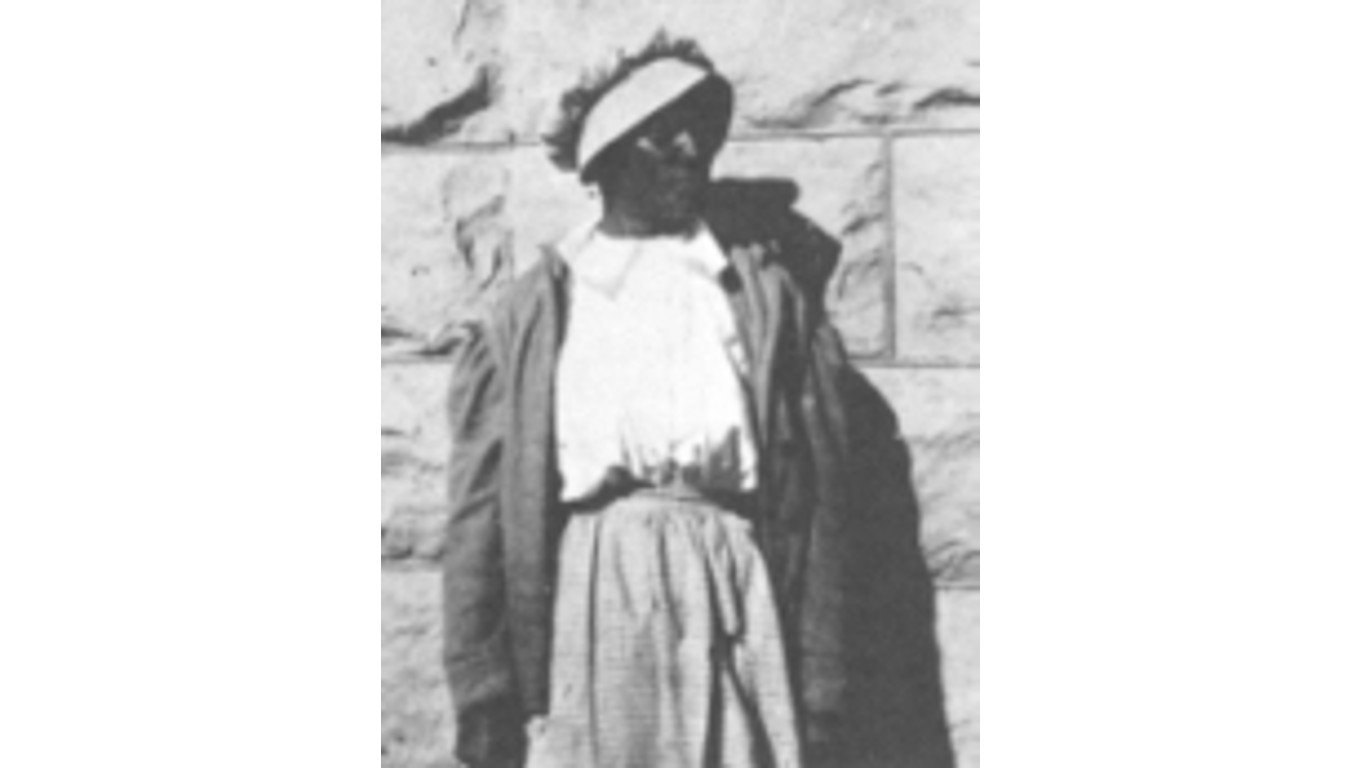
Cathay Williams
> Rank: Private
> Division: Army, 38th U.S. Infantry Regiment
> Years served: 1861-1868
> War(s): Civil War
The first Black woman to enlist in the U.S. Army spent her adolescence as a house slave on a plantation near Jefferson City, Missouri. After Union forces occupied the city during the Civil War, Williams and other slaves were conscripted to serve in military support roles like cooks, laundresses, and nurses, according to the National Park Service. After the war, Williams enlisted in the U.S. Army by posing as a man named William Cathay. She served as the only known female Buffalo Soldier – the name given to members of Black cavalry regiments formed after the Civil War. Williams was honorably discharged in 1868 after doctors discovered she was a woman during treatment for smallpox.
[in-text-ad]

Harriet Tubman
> Rank: Spymaster, military scout
> Division: Served under multiple commanders
> Years served: 1861-1865
> War(s): Civil War
After fleeing north out of Maryland with her two brothers in 1849, Tubman began working in the Underground Railroad network of safe houses that had helped her escape. She returned to the South so frequently to help other enslaved people flee captivity that a group of slaveowners offered a $40,000 reward for her capture or death, notes the National Women’s History Museum. Recognizing the strategic value of a clandestine communications network in enemy territory, Union military commanders recruited Tubman to serve as a spy and scout. Kept out of military records, it would take decades for Tubman to win recognition for her service. Finally, in 1899, Tubman was granted a military pension.
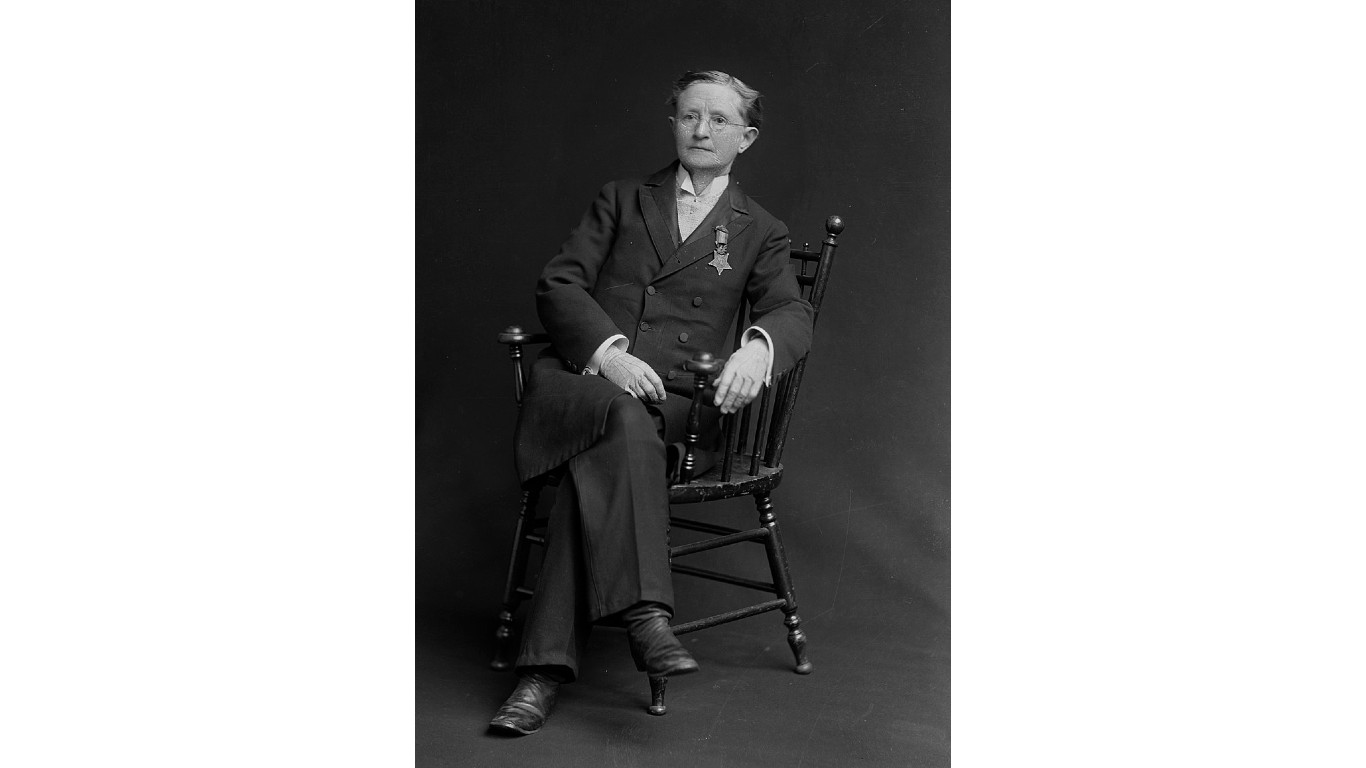
Mary E. Walker
> Rank: Surgeon
> Division: 52d Ohio Regiment
> Years served: 1861-1865
> War(s): Civil War
The only woman to have received the Medal of Honor, the highest U.S. military decoration, earned the recognition for her work as a Union field surgeon during the Civil War, operating so close to the frontline that she was captured and held prisoner by the Confederates in the latter years of the war. Walker was an avid and vocal supporter of women’s empowerment, which didn’t always sit well with the men around her. “Walker’s politics managed to engender a good deal of controversy as an army doctor, specifically regarding her dress,” says the American Battlefield Trust. Walker felt the skirts and corsets of Victorian women’s clothing were too restrictive for her work and she opted for a simple skirt over trousers, a practical but scandalous fashion choice for its time.

Sarah Emma Edmonds
> Rank: Nurse
> Division: 2nd Michigan Infantry
> Years served: 1861-1865
> War(s): Civil War
Like Cathay Williams (on this list, above), Edmonds concealed her gender when she enlisted as a male field nurse. She served in battlefield hospitals, including those at the bloody second battles of Manassas and Antietam, notes the National Park Service. Edmonds left the military after contracting malaria, realizing that doctors would discover her gender during treatment. In 1865, Edmonds published a memoir about her war experience and continued treating wounded soldiers, this time as a female nurse, at a military hospital in Washington D.C. Edmonds was eventually granted an honorable discharge and a pension.
[in-text-ad-2]

Opha May Johnson
> Rank: Private
> Division: Marine Corps Reserve
> Years served: 1918-1919
> War(s): WWI
The first woman to enlist in the Marine Corps, in August 1918, was one of more than 300 female Marines who served in World War I. Johnson worked as a clerk at Marine Corps headquarters. Johnson and other women filled administrative positions in the armed services until the military began to disenroll women after the war. Johnson later served as a civilian clerk in the War Department.

Ruby Bradley
> Rank: Colonel
> Division: Army Nurse Corps
> Years served: 1934-1964
> War(s): World War II and Korean War
One of the most decorated women to ever serve in the U.S. military, Bradley enlisted in 1934 as an Army nurse, serving close enough to the frontlines to be captured by the Japanese in the Philippines. Over 37 grueling months of captivity, Bradley helped to set up a medical dispensary in the POW camp and assisted in more than 200 surgeries and 13 births. Bradley served at base hospitals before returning overseas as a combat nurse during the Korean War, at one point barely escaping an evacuated ambulance as it was exploded by an enemy shell.
[in-text-ad]
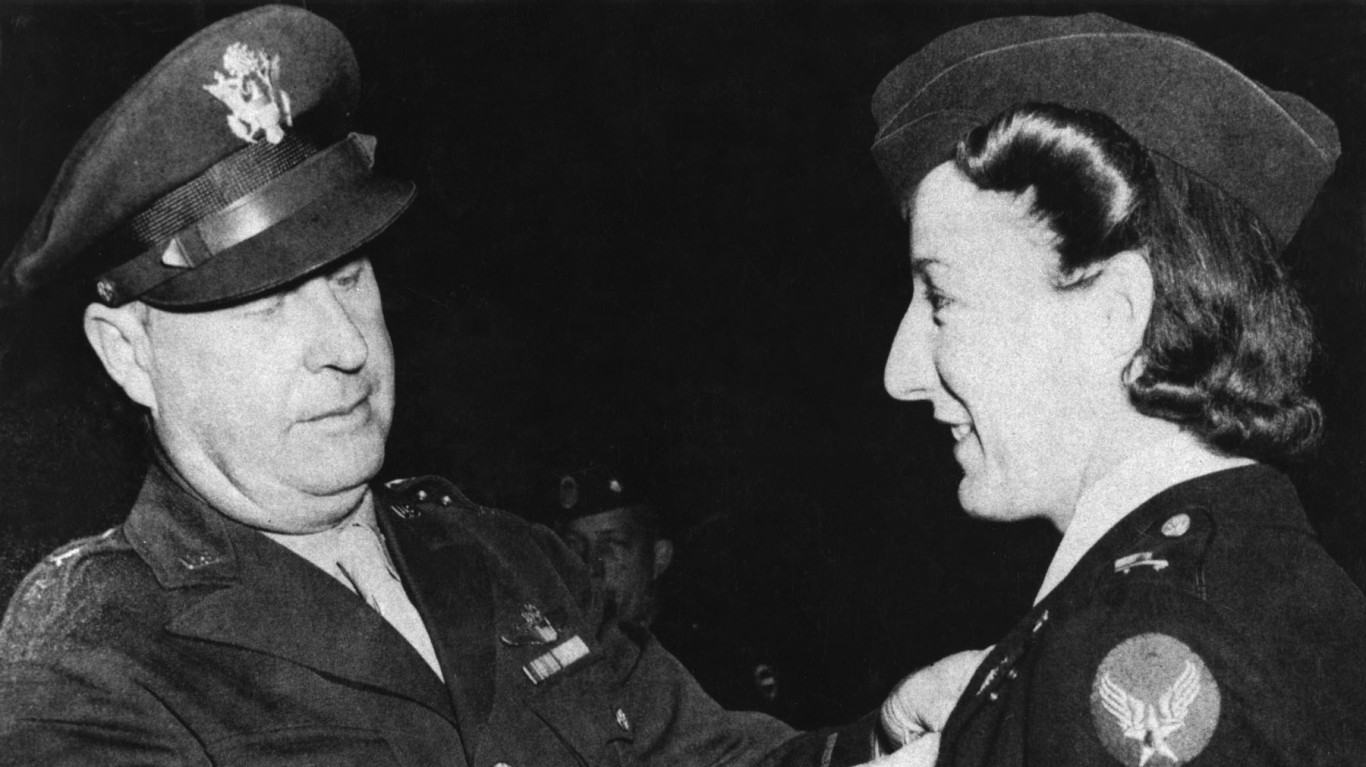
Elsie Ott
> Rank: Lieutenant
> Division: US Army Air Corps
> Years served: 1941-1946
> War(s): WWII
This pioneer in military medicine participated in the first intercontinental air evacuation flight, which took place in January 1943 when five wounded soldiers were shuttled from Karachi to Walter Reed hospital in Washington D.C. The only supplies made available to Ott were bedding and a single first aid kit. Ott’s feedback about that trip helped the military improve air evacuation procedures, making aircraft more like flying ambulances. Ott was promoted to captain before her honorable discharge in 1946.
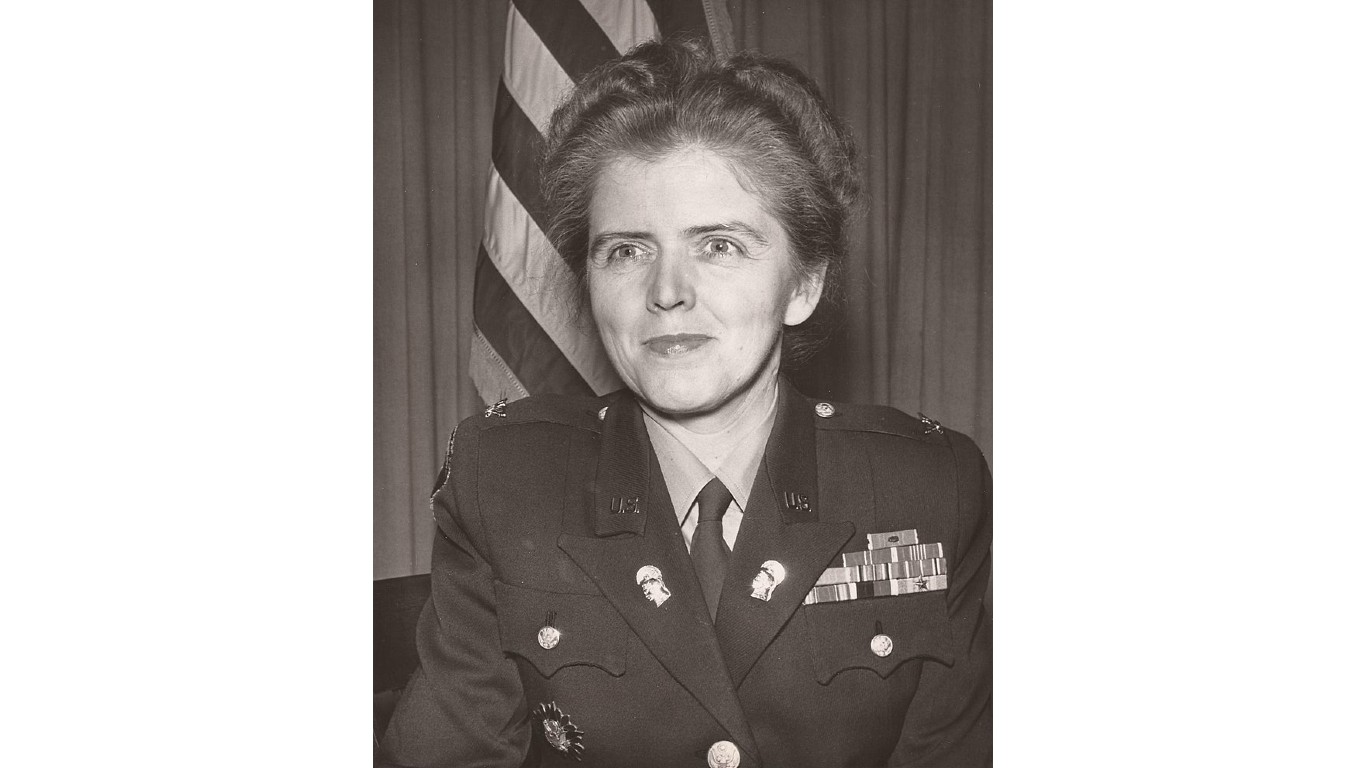
Mary Hallaran
> Rank: Colonel
> Division: Women’s Auxiliary Army Corps
> Years served: 1942-1960
> War(s): WWII, Korea
Hallaran was instrumental in pushing the U.S. armed forces toward making women a regular part of the military, not just mobilizing them during wartime. “To me there was no question that women should serve,” she once said, according to her 2005 obituary in the New York Times. During World War II, Hallaran led the first battalion of the Women’s Army Auxiliary Corps in Europe, the largest women’s unit that served overseas during the war. Congress signed the U.S. Women’s Armed Services Integration Act in 1948 and Hallaran was sworn in as the first woman officer of the Army outside of its medical branch.
Bea Arthur
> Rank: Private
> Division: US Marine Corps Women’s Reserve
> Years served: 1943-1945
> War(s): WWII
The late television actor might not have a remarkable military career compared to other women on this list, but the fact she enlisted in the U.S. Marine Corps (under her original name Bernice Frankel) in 1943 to serve as a truck driver and typist combined with her fame certainly helped to illustrate the role women have played in the U.S. military. The star of the “Maude” and “The Golden Girls” television series, who died in 2009, was known for her delightfully salty demeanor, which got her noticed by enlistment officers, who described her as “argumentative” and “over aggressive.”
[in-text-ad-2]

Grace Brewster Murray Hopper
> Rank: Rear Admiral
> Division: US Navy Computer Intelligence
> Years served: 1943-1992
> War(s): World War II, Korean War, Vietnam
After the bombing of Pearl Harbor, the Yale-educated mathematician joined the U.S. Naval Reserve (Women’s Reserve) and was later assigned to the Bureau of Ships Computation Project at Harvard University to calculate rocket trajectories and create range tables for new anti-aircraft guns. “Hopper is best known for her trailblazing contributions to computer programming, software development, and the design and implementation of programming languages,” says Yale’s website. Hopper was instrumental in creating word-based programming languages and was the primary mind behind the innovative COBOL programming language.
Ann E. Dunwoody
> Rank: General
> Division: 82nd Airborne Division
> Years served: 1975-2012
> War(s): Served at Fort Bragg and Fort Belvoir
During the First Gulf War in 1992, Dunwoody became the first woman to lead a battalion in the 82nd Airborne Division. She earned another first in 2008 when she became the first woman to reach the rank of four-star officer. “It’s important that we remember the generations of women, whose dedication, commitment and quality of service helped open the doors of opportunity for us today,” she said following confirmation of her promotion. Dunwoody was head of Army Materiel Command until her retirement in 2012.
[in-text-ad]

Rhonda Cornum
> Rank: Brigadier General
> Division: Landstuhl Regional Medical Center
> Years served: 1978-2012
> War(s): Iraq
Cornum’s memoir “She Went to War: The Rhonda Cornum Story,” about her experience as a prisoner of war during the First Gulf War of 1991, helped to convince the country that women can serve in combat roles in the military. The flight surgeon was shot down during a search-and-rescue mission and held by Iraqi soldiers for eight days. She admitted that she was sexually molested while in captivity, but she dismissed the notion that sexual assault be used as a reason to block women from frontline roles. “Since everything that happens to you as a prisoner of war is non-consensual, then the fact that one thing they did was non-consensual is not very relevant,” Cornum told the Washington Post in 1992.
Darlene Iskra
> Rank: Commander
> Division: Commander of the USS Opportune (ARS-41)
> Years served: 1979-2000
> War(s): N/A
The first woman to command a U.S. Navy ship has written two books about women in the military. In one section she describes the reaction to her historic promotion: “I hadn’t realized what a big deal being the first woman to command a ship would be until I arrived in Naples, and on my desk was a stack of congratulatory cards and letters from people I didn’t even know!” Iskra retired in 2000 after 21 years in the U.S. Navy and obtained a Ph.D. in sociology from the University of Maryland.

Marcella Hayes Ng
> Rank: Lieutenant colonel
> Division: 394th Transportation Battalion
> Years served: 1979-2000
> War(s): N/A
The first Black female pilot in the U.S. military started her career as an ROTC cadet at the University of Wisconsin and later completed helicopter flight training from Army Flight School at Fort Rucker, Alabama, in 1979. She also became the first Black soldier and first woman to lead the 394th Transportation Battalion. The Army Women’s Foundation describes a young Hayes as “a tomboy, a tree-climber who played tackle football with her cousins and who liked to watch her grandfather work under the hood of automobiles.”
[in-text-ad-2]
Eileen Collins
> Rank: Colonel
> Division: Air Force Space Shuttle commander
> Years served: 1979-2006
> War(s): N/A
In July 1999, Collins became the first woman to command a space shuttle mission, four years after becoming the first woman to pilot a space shuttle. She joined the Air Force in 1979 and subsequently worked as a T-38 flight instructor and a C-141 Starlifter aircraft commander. Collins spent much of her military career as a flight instructor, giving her the experience to become an astronaut in 1991. During her service, Collins logged more than 5,000 hours in dozens of different aircraft and 537 hours in orbit.

Linda Bray
> Rank: Captain
> Division: 988th Military Police Company
> Years served: 1982-1991
> War(s): Panama invasion
Bray became the first woman to command U.S. soldiers in battle as part of Operation Just Cause in Panama in 1989, the mission to depose Gen. Manuel Noriega and arrest him for racketeering and drug trafficking. Bray led the 988th Military Police Company and her service helped the U.S. military to re-evaluate its ban on women in military combat roles. In 2013, then-Defense Secretary Leon Panetta lifted the ban.
[in-text-ad]
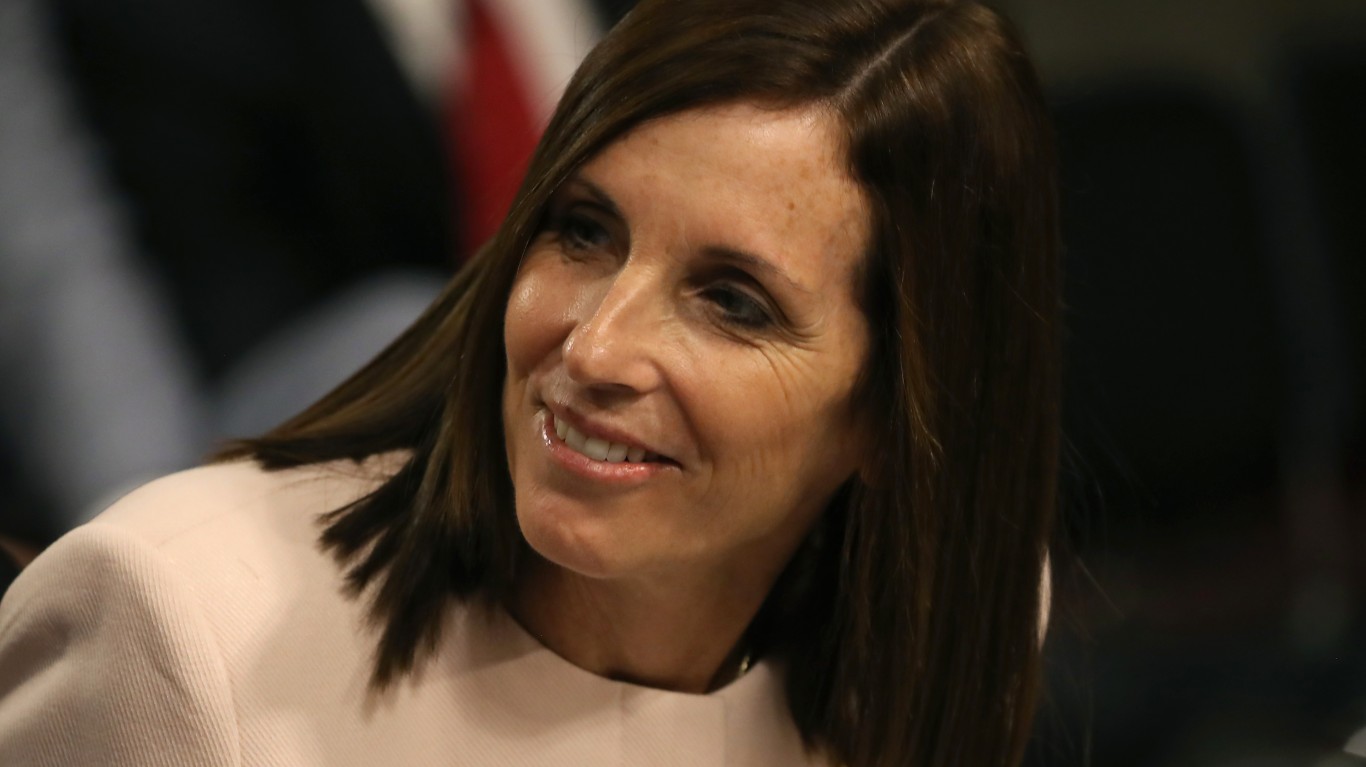
Martha McSally
> Rank: Lieutenant colonel
> Division: 354th Fighter Squadron
> Years served: 1995-2010
> War(s): Iraq
McSally became the first woman to fly combat missions when she piloted an A-10 Thunderbolt II “Warthog” tank-killer aircraft over Kuwait and Iraq during Operation Southern Watch, the mission to enforce the Iraq no-fly zone following the end of the First Gulf War. She also became the first woman to command a U.S. Air Force fighter squadron. McSally, who now serves as a Republican House representative from Arizona, successfully sued the Pentagon for requiring U.S. service women in Saudi Arabia to wear the abaya, the body-length black robe the Saudi government required all women to wear in public at the time.
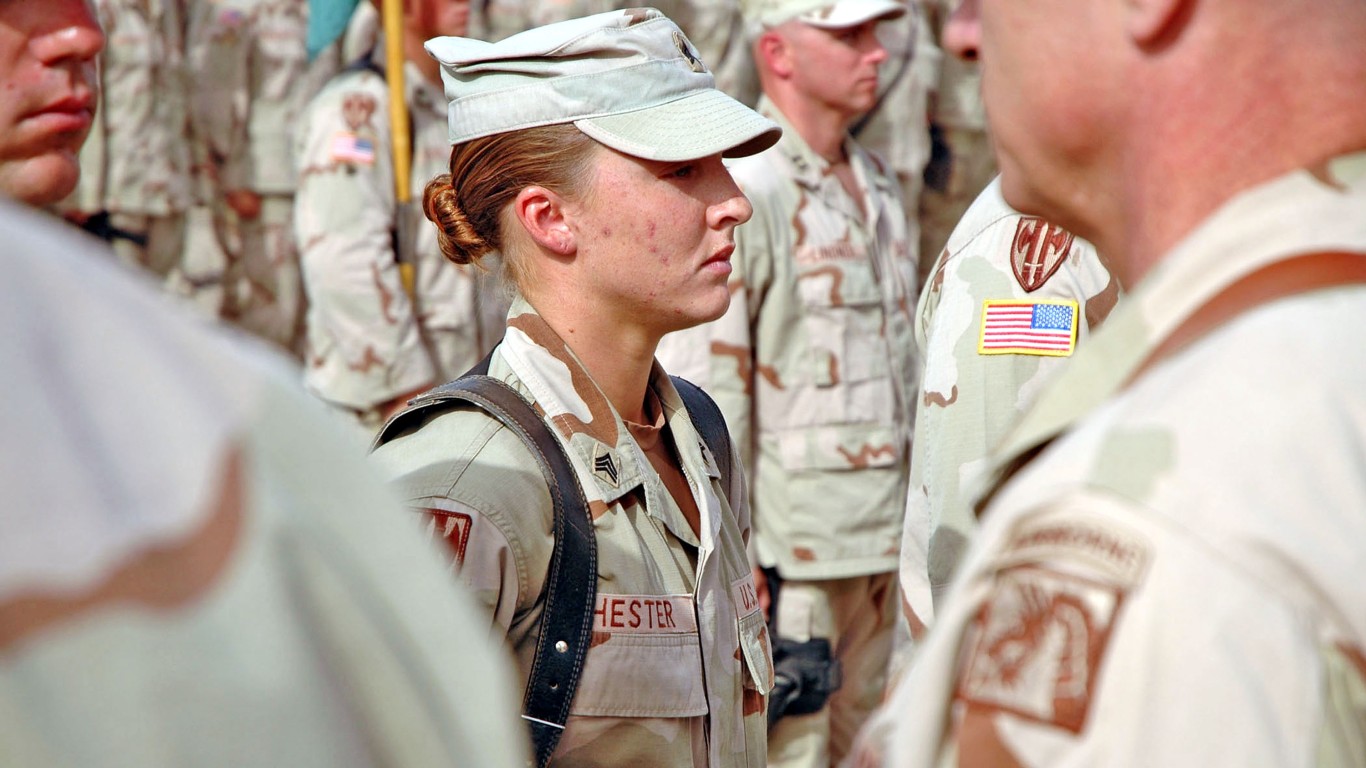
Leigh Ann Hester
> Rank: Sergeant
> Division: 617th Military Police Company
> Years served: 2001-Present
> War(s): Iraq
While traveling with a supply convoy on March 20, 2005, Hester’s 617th Military Police Company was ambushed by fighters in Iraq. Hester led her team through open fire into a flanking position where she attacked the entrenched insurgents with grenade launcher rounds and killed three other fighters with a rifle. At the end of the skirmish, 27 insurgents were dead and six more were injured. For her valor, Hester became the first woman to earn a Silver Star, the country’s third-highest military decoration, since World War II.

Kristen M. Griest
> Rank: Captain
> Division: MP platoon leader
> Years served: 2015- Present
> War(s): N/A
Griest was one of the first two women to complete the demanding 62-day Army Ranger School tactics and leadership course in 2015. The school was founded in 1950 at Fort Benning, Georgia, to root out all but the most resilient soldiers. Griest served as a Military Police platoon leader before embarking on the challenges of becoming a Ranger. In 2021, Griest criticized changes to the Army Combat Fitness Test that made it easier for women to pass. “To not require women to meet equal standards in combat arms will not only undermine their credibility, but also place those women, their teammates, and the mission at risk,” she wrote in an op-ed for the Modern War Institute.
[in-text-ad-2]

Shaye L. Haver
> Rank: 1st. Lieutenant
> Division: Helicopter pilot
> Years served: 2015- Present
> War(s): N/A
Haver was the other of two first women to become U.S. Army Rangers after completing the intensive 62-day Army Ranger School tactics and leadership course. Before becoming a Ranger, Haver was trained to fly an AH-64 Apache helicopter. “The reasons I chose to come were the same as the men here: to get the experience of the elite leadership school and to give me the opportunity to lead my Soldiers the best that I can,” Have said at the time. Since Griest and Haver broke through this brass ceiling, more than 30 women have passed Army Ranger School.
Are You Ahead, or Behind on Retirement? (sponsor)
If you’re one of the over 4 Million Americans set to retire this year, you may want to pay attention.
Finding a financial advisor who puts your interest first can be the difference between a rich retirement and barely getting by, and today it’s easier than ever. SmartAsset’s free tool matches you with up to three fiduciary financial advisors that serve your area in minutes. Each advisor has been carefully vetted, and must act in your best interests. Start your search now.
Don’t waste another minute; get started right here and help your retirement dreams become a retirement reality.
Thank you for reading! Have some feedback for us?
Contact the 24/7 Wall St. editorial team.
